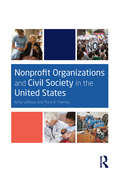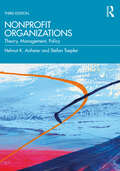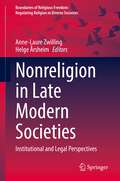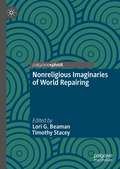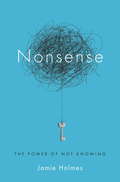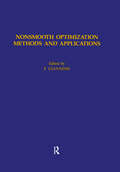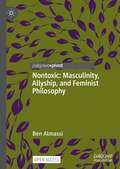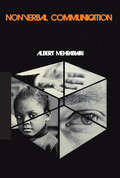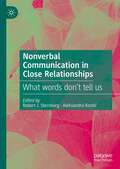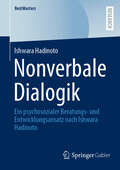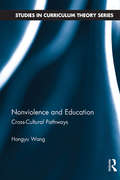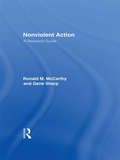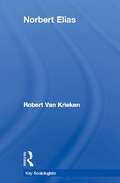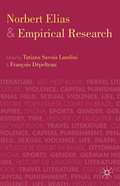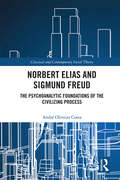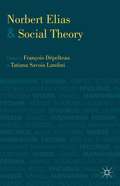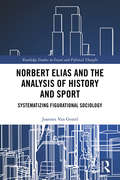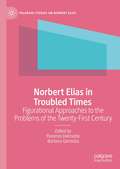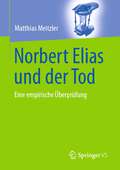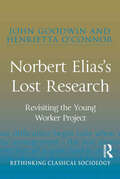- Table View
- List View
Nonprofit Organizations and Civil Society in the United States
by Mary K. Feeney Kelly LeRouxLeRoux and Feeney’s Nonprofit Organizations and Civil Society in the United States makes a departure from existing nonprofit texts on the market: rather than focus on management, it focuses on nonprofit organizations and their contributions to the social, political, and economic dimensions of society. The book also covers the nexus between nonprofits and civil society. This text offers a theory-oriented undergraduate introduction to the nonprofit field and an examination of the multifaceted roles these organizations play in American society.
Nonprofit Organizations: Theory, Management, Policy
by Helmut K. Anheier Stefan ToeplerIn this new edition of the popular textbook, Nonprofit Organizations: Theory, Management, Policy, Helmut K. Anheier and Stefan Toepler have fully updated, revised, and expanded this comprehensive introduction to a growing field. The text takes on an international and comparative perspective, detailing the background and concepts and examining relevant theories and central issues. Anheier and Toepler cover the full range of nonprofit organizations—service providers, membership organizations, foundations, community groups—in different fields, such as arts and culture, health and social services, and education. Introducing central terms such as philanthropy, charity, social entrepreneurship, social investment, and civil society, they explain how the field relates to public management and administration. This textbook is systematic in its approach to theories, management, and policy. The first edition won the Best Book Award at the American Academy of Management in 2006, and this new edition will continue to match the growing demand for academic teaching. Nonprofit Organizations: Theory, Management, Policy is an ideal resource for students of both undergraduate and postgraduate courses.
Nonreligion in Late Modern Societies: Institutional and Legal Perspectives (Boundaries of Religious Freedom: Regulating Religion in Diverse Societies)
by Anne-Laure Zwilling Helge ÅrsheimThis volume presents results from new and ongoing research efforts into the role of nonreligion in education, politics, law and society from a variety of different countries. Featuring data from a wide range of quantitative and qualitative studies, the book exposes the relational dynamics of religion and nonreligion. Firstly, it highlights the extent to which nonreligion is defined and understood by legal and institutional actors on the basis of religions, and often replicates the organisation of society and majority religions. At the same time, it displays how essential it is to approach nonreligion on its own, by freeing oneself from the frameworks from which religion is thought.The book addresses pressing questions such as: How can nonreligion be defined, and how can the “nones” be grasped and taken into account in studies on religion? How does the sociocultural and religious backdrop of different countries affect the regulation and representation of nonreligion in law and policymaking? Where and how do nonreligious individuals and collectives fit into institutions in contemporary societies? How does nonreligion affect notions of citizenship and national belonging? Despite growing scholarly interest in the increasing number of people without religion, the role of nonreligion in legal and institutional settings is still largely unexplored.This volume helps fill the gap, and will be of interest to students, researchers, policymakers and others seeking deeper understanding of the changing role of nonreligion in modern societies.
Nonreligious Imaginaries of World Repairing
by Lori G. Beaman Timothy StaceyThe world is confronted with multiple intersecting crises including exploitation, inequality, political polarization and climate change. World-repairing work is vitally needed. But just at a time when humans most obviously require robust moral imaginaries on which to draw, it is no longer clear what kinds of beliefs, meanings, stories and encounters inspire them to act. We know that nonreligious identities are on the rise in numerous countries throughout the world. But with so much focus on the “non” part of nonreligion, what we don’t know is what nonreligious imaginaries actually look, sound and feel like. What do nonreligious people believe in? What stories inspire them? In what moments do they find meaning? This book seeks to answer these questions through a series of short essays exploring the nonreligious imaginaries that emerge in a range of world-repairing practices, including ethical consumption, community organizing, eating habits, and environmental activism. In so doing, the book provides a crucial contribution to two areas of increasing social and political concern: First, the need to understand not only what nonreligious people are rejecting but also their sources of meaning and action. Second, the urgent need for cultural tools for mobilizing people towards more compassionate and sustainable practices.
Nonsense: The Power of Not Knowing
by Jamie HolmesAn illuminating look at the surprising upside of ambiguity--and how, properly harnessed, it can inspire learning, creativity, even empathy Life today feels more overwhelming and chaotic than ever. Whether it's a confounding work problem or a faltering relationship or an unclear medical diagnosis, we face constant uncertainty. And we're continually bombarded with information, much of it contradictory. Managing ambiguity--in our jobs, our relationships, and daily lives--is quickly becoming an essential skill. Yet most of us don't know where to begin. As Jamie Holmes shows in Nonsense, being confused is unpleasant, so we tend to shutter our minds as we grasp for meaning and stability, especially in stressful circumstances. We're hard-wired to resolve contradictions quickly and extinguish anomalies. This can be useful, of course. When a tiger is chasing you, you can't be indecisive. But as Nonsense reveals, our need for closure has its own dangers. It makes us stick to our first answer, which is not always the best, and it makes us search for meaning in the wrong places. When we latch onto fast and easy truths, we lose a vital opportunity to learn something new, solve a hard problem, or see the world from another perspective. In other words, confusion--that uncomfortable mental place--has a hidden upside. We just need to know how to use it. This lively and original book points the way. Over the last few years, new insights from social psychology and cognitive science have deepened our understanding of the role of ambiguity in our lives and Holmes brings this research together for the first time, showing how we can use uncertainty to our advantage. Filled with illuminating stories--from spy games and doomsday cults to Absolut Vodka's ad campaign and the creation of Mad Libs--Nonsense promises to transform the way we conduct business, educate our children, and make decisions. In an increasingly unpredictable, complex world, it turns out that what matters most isn't IQ, willpower, or confidence in what we know. It's how we deal with what we don't understand.From the Hardcover edition.
Nonsexist Research Methods: A Practical Guide
by Margrit EichlerFirst published in 1988. Routledge is an imprint of Taylor & Francis, an informa company.
Nonsmooth Optimization Methods
by F. GiannessiNonsmooth Optimization Methods and Applications provides an overview of this branch of mathematics, concentrating on the interaction between the theory and its applications.
Nontechnical Strategies To Reduce Children's Exposure To Inappropriate Material On The Internet: Summary Of A Workshop
by Committee to Study Tools Strategies for Protecting Kids from Pornography Their Applicability to Other Inappropriate Internet ContentThe National Academies Press (NAP)--publisher for the National Academies--publishes more than 200 books a year offering the most authoritative views, definitive information, and groundbreaking recommendations on a wide range of topics in science, engineering, and health. Our books are unique in that they are authored by the nation's leading experts in every scientific field.
Nontoxic: Masculinity, Allyship, and Feminist Philosophy
by Ben AlmassiThis open access book argues for allyship masculinity as an open-ended, intersectional model for feminist men. It provides a roadmap for navigating between toxic masculinity on one side, and feminist androgyny on the other. Normative visions for what men should be take many forms. For some it is love and mindfulness; for others, wildness and heroic virtue. For still others the desire to separate a healthy manhood from toxic masculinity is a mistake: better to refuse to be men and salvage our humanity. Though Ben Almassi challenges the visions that Mary Wollstonecraft, bell hooks, and others have offered, he shares their belief that masculinity can be grounded in feminist values and practices. Almassi argues that we can make sense of relational allyship as practices of feminist masculinity, such that men can make distinctive and constructive contributions to gender justice in the unjust meantime.
Nonverbal Behavior and Communication
by Aron W. Siegman Stanley FeldsteinFirst published in 1987. Routledge is an imprint of Taylor & Francis, an informa company.
Nonverbal Communication
by Albert MehrabianEven though our society subtly discourages the verbal expression of emotions, most of us, in ostensibly conforming to our roles, nevertheless manage to express likes, dislikes, status differences, personalities, as well as weaknesses in nonverbal ways. Using vocal expressions; gestures, postures, and movements, we amplify, restrict, or deny what our words say to one another, and even say some things with greater facility and efficiency than with words.In this new, multidimensional approach to the subject of nonverbal communication Albert Mehrabian brings together a great deal of original work which includes descriptions of new experimental methods that are especially suited to this field, detailed findings of studies scattered throughout the literature, and most importantly, the integration of these findings within a compact framework.The framework starts with the analysis of the meanings of various nonverbal behaviors and is based on the fact that more than half of the variance in the significance of nonverbal signals can be described in terms of the three orthogonal dimensions of positiveness, potency or status, and responsiveness. These three dimensions not only constitute the semantic space for nonverbal communication, but also help to identify groups of behaviors relating to each, to describe characteristic differences in nonverbal communication, to analyze and generate rules for the understanding of inconsistent messages, and to provide researchers with new and comprehensive measures for description of social behavior.This volume will be particularly valuable for both the professional psychologist and the graduate student in psychology. It will also be of great interest to professionals in the fields of speech and communication, sociology, anthropology, and psychiatry.
Nonverbal Communication in Close Relationships
by Laura K. Guerrero Kory FloydNonverbal Communication in Close Relationships provides a synthesis of research on nonverbal communication as it applies to interpersonal interaction, focusing on the close relationships of friends, family, and romantic partners. Authors Laura K. Guerrero and Kory Floyd support the premise that nonverbal communication is a product of biology, social learning, and relational context. They overview six prominent nonverbal theories and show how each is related to bio-evolutionary or sociocultural perspectives. Their work focuses on various functions of nonverbal communication, emphasizing those that are most relevant to the initiation, maintenance, and dissolution of close relationships. Throughout the book, Guerrero and Floyd highlight areas where research is either contradictory or inconclusive, hoping that in the years to come scholars will have a clearer understanding of these issues. The volume concludes with a discussion of practical implications that emerge from the scholarly literature on nonverbal communication in relationships – an essential component for understanding relationships in the real world. Nonverbal Communication in Close Relationships makes an important contribution to the development of our understanding not only of relationship processes but also of the specific workings of nonverbal communication. It will serve as a springboard for asking new questions and advancing new theories about nonverbal communication. It is intended for scholars and advanced students in personal relationship study, social psychology, interpersonal communication, nonverbal communication, family studies, and family communication. It will also be a helpful resource for researchers, clinicians, and couples searching for a better understanding of the complicated roles that nonverbal cues play in relationships.
Nonverbal Communication in Close Relationships: What words don’t tell us
by Robert J. Sternberg Aleksandra KostićThis book is an up-to-date compendium of knowledge on the secret language of close relationships, namely nonverbal routes of communication. In close relationships, as everyone learns sooner or later, the usefulness of words can be somewhat limited, because people (a) mean different things by the same words, (b) mean the same thing by different words, (c) sometimes find it hard to express their feelings in words, and (d) lie. Nonverbal signals therefore often provide the best means of communication. The book points out how decoding (interpreting) nonverbal signals is a major key to success, because often what people say wholly belies how they feel—nonverbal signals reveal their true feelings rather than what they want other people to think their feelings are. This book helps decode those secret signals. The book is written by the leading worldwide experts in the field of nonverbal communication to ensure accuracy, comprehensiveness, and timeliness.
Nonverbale Dialogik: Ein psychosozialer Beratungs- und Entwicklungsansatz nach Ishwara Hadinoto (BestMasters)
by Ishwara HadinotoZentral für viele Organisationen und ihre Mitglieder ist das „Doppelbindungsdilemma“; es manifestiert sich in einem tiefgreifenden Kommunikationsproblem: Oftmals übermitteln die Betroffenen durch subtile nonverbale Signale ihre Vorwürfe, trauen sich jedoch nicht, das eigentliche Problem offen anzusprechen. Sie fürchten negative Reaktionen oder Sanktionen. Diese Dynamik kann für Organisationen weitreichende Auswirkungen haben. Hier kommt Ishwara Hadinoto’s Konzept der „Nonverbalen Dialogik“ ins Spiel. Diese Arbeit betrachtet verschiedene Dimensionen des Selbstwerts. Von großer Bedeutung ist dabei die zentrale Rolle nonverbaler Kommunikation und von Doppelbindungen als ursächliche Stressfaktoren. Nach einer Analyse zur Konfliktlösung wird dargelegt, wie die Nonverbale Dialogik Psychoanalyse, Humanistische Psychologie und daoistische Philosophie in einem innovativen Ansatz verbindet. Schließlich wird das Augenmerk auf die direkte Anwendung der Methode und ihre messbaren Auswirkungen auf Coachees gerichtet.
Nonviolence and Education: Cross-Cultural Pathways (Studies in Curriculum Theory Series)
by Hongyu WangIn current global politics, which positions China as a competitor to American leadership, in-depth understandings of transnational mutual engagement are much needed for cultivating nonviolent relations. Exploring American and Chinese professors’ experiences at the intersection of the individual, society, and history, and weaving the autobiographical and the global, this book furthers understanding of their cross-cultural personal awareness and educational work at universities in both countries. While focusing on life histories, it also draws on both American and Chinese intellectual traditions such as American nonviolence activism, Taoism, and Buddhism to formulate a vision of nonviolence in curriculum studies. Centering cross-cultural education and pedagogy about, for, and through nonviolence, this volume contributes to internationalizing curriculum studies and introduces curriculum theorizing at the level of higher education. Hongyu Wang brings together stories, dialogues, and juxtapositions of cross-cultural pathways and pedagogies in a powerful case for theorizing and performing nonviolence education as visionary work in the internationalization of curriculum studies.
Nonviolence and Peace Psychology
by Daniel MaytonRecent trends and events worldwide have increased public interest in nonviolence, pacifism, and peace psychology as well as professional interest across the social sciences. Nonviolence and Peace Psychology assembles multiple perspectives to create a more comprehensive and nuanced understanding of the concepts and phenomena of nonviolence than is usually seen on the subject. Through this diverse literature--spanning psychology, political science, religious studies, anthropology, and sociology--peace psychologist Dan Mayton gives readers the opportunity to view nonviolence as a body of principles, a system of pragmatics, and a strategy for social change. This important volume: Draws critical distinctions between nonviolence, pacifism, and related concepts. Classifies nonviolence in terms of its scope (intrapersonal, interpersonal, societal, global) and pacifism according to political and situational dimensions. Applies standard psychological concepts such as beliefs, motives, dispositions, and values to define nonviolent actions and behaviors. Brings sociohistorical and cross-cultural context to peace psychology. Analyzes a century's worth of nonviolent social action, from the pathbreaking work of Gandhi and King to the Courage to Refuse movement within the Israeli armed forces. Reviews methodological and measurement issues in nonviolence research, and suggests areas for future study. Although more attention is traditionally devoted to violence and aggression within the social sciences, Nonviolence and Peace Psychology reveals a robust knowledge base and a framework for peacebuilding work, granting peace psychologists, activists, and mediators new possibilities for the transformative power of nonviolence.
Nonviolent Action: A Research Guide (History Reference Ser.)
by Gene Sharp Ronald M. McCarthy Brad BennettFirst published in 1998. Routledge is an imprint of Taylor & Francis, an informa company.
Norbert Elias
by Robert Van KriekenThis book locates Elias's work clearly within the development of sociology and also against the background of current debates.Between the 1930s and the 1980s he developed a unique approach to social theory which is now beginning to take root in contemporary social research and theory. Since the translation of his work into English began to accelerate in the 1980s, a growing number of books and articles on topics including health, sexuality, crime, national and ethnic identity, femininity and globalization, in a variety of disciplines, make positive reference to Elias as an authority on the history of emotions, identity, violence, the body and state formation.
Norbert Elias and Empirical Research
by Fran�ois D�pelteau Tatiana Savoia LandiniNorbert Elias has been recognized as one of the key social scientists of the 20th century at least in sociology, political science and history. This book will address Norbert Elias's approach to empirical research, the use of his work in empirical research, and compare him with other theorists.
Norbert Elias and Sigmund Freud: The Psychoanalytic Foundations of the Civilizing Process (Classical and Contemporary Social Theory)
by André Oliveira CostaThis book explores the influence of Freudian psychoanalysis on Norbert Elias’ theory of the civilizing process – an influence acknowledged by Elias himself – conducting a dialogue with a view to analyzing points of contact and distance between them. Examining the development of Elias’ work, it sheds light on the integration of psychoanalytic concepts in his thought, considering the dynamics that exist between individuals and social processes, as the civilizing process affects the psychic economy of individuals and psychic structures serve to sustain civilization. A genealogical study of Freudian concepts as expressed in the trajectory of Elias’s sociology, it will appeal to scholars of sociology and psychology with interests in social and psychoanalytic theory.
Norbert Elias and Social Theory
by X00e9 Fran X00e7 Ois D PelteauThis book will compare the approach and works of Norbert Elias, well known for his analysis of the civilizing process, his work on sport and violence and, more largely, his figurational approach, with other important social theories both classical and contemporary.
Norbert Elias and the Analysis of History and Sport: Systematizing Figurational Sociology (Routledge Studies in Social and Political Thought)
by Joannes Van GestelIn times when the social sciences have become increasingly fragmented and more focused on ‘the pieces of the puzzle’, the puzzle, as a topic in its own right, has slowly been moved towards the background. Nonetheless, as humanity becomes ever more globalized, there is a greater need for in-depth discussion on the theory behind the direction of humanity in history and the interrelationships between the different areas in which humans associate, including that of leisure and sport. At its heart, Norbert Elias and the Analysis of History and Sport explains both the course of history and how the roles that leisure and sport have occupied in it should be investigated. Exploring this from Norbert Elias’ figurational (or process sociological) standpoint, the book offers a unique perspective as Van Gestel approaches the theoretical concepts and ideas by systematizing the views of the iconic scholar and offers new insights into his central theory. Furthermore, drawing upon theoretical principles that are universal to humans rather than relative to a case study, Van Gestel offers an applicable guideline which explains phenomena beyond specific cultures or circumstances that have so far been a customary practice by process sociologists. Norbert Elias and the Analysis of History and Sport is a valuable title which will appeal to postgraduate students and scholars interested in fields such as social studies, leisure and sport studies, and history.
Norbert Elias in Troubled Times: Figurational Approaches to the Problems of the Twenty-First Century (Palgrave Studies on Norbert Elias)
by Barbara Górnicka Florence DelmotteThis edited collection brings together texts that discuss current major issues in our troubled times through the lens of Norbert Elias’s sociology. It sheds light on both the contemporary world and some of Elias’s most controversial concepts. Through examination of the ‘current affairs’, political and social contemporary changes, the authors in this collection present new and challenging ways of understanding these social processes and figurations. Ultimately, the objective of the book is to embrace and utilise some of the more polemical aspects of Elias’s legacy, such as the exploration of decivilizing processes, decivilizing spurts, and dys-civilization. It investigates to what extent Elias’s sociological analyses are still applicable in our studies of the developments that mark our troubled times. It does so through both global and local lenses, theoretically and empirically, and above all, by connecting past, present, and possible futures of all human societies.
Norbert Elias und der Tod: Eine empirische Überprüfung
by Matthias MeitzlerDer Einfluss von Norbert Elias als soziologischer Klassiker ist unbestritten. Dieser Status verdankt sich in erster Linie seiner Theorie vom Zivilisationsprozess. In dessen Geist steht auch Elias‘ 1982 erschienenes und in mehrere Sprachen übersetztes Buch Über die Einsamkeit der Sterbenden in unseren Tagen. Dort widmet er sich der Frage, wie Menschen der Endlichkeit des Lebens gegenüberstehen, unter welchen Bedingungen sie sterben, sich voneinander verabschieden, umeinander trauern und sich aneinander erinnern. Im Zentrum steht die Einsicht, dass es immerzu die Lebenden sind, die das Sterblichkeitsproblem zu bewältigen haben. Menschen in zivilisierten Gesellschaften tun dies Elias zufolge, indem sie Sterben und Tod verdrängen. Als schambesetztes Thema werde das Lebensende in alltäglichen Gesprächssituationen zumeist ausgeblendet; ferner haben sich Sterbeprozesse im Zuge sozialer Ausdifferenzierung vom heimischen Familienumfeld in Institutionen wie das Krankenhaus verlagert. Diese Entwicklung führe dazu, dass heute anders gestorben werde als früher: steril, geräuschlos, unauffällig – und vor allem einsam. Für die thanatosoziologische Erforschung des Umgangs mit Sterben, Tod und Trauer erwies sich Elias‘ Studie als Meilenstein. Kein anderes deutschsprachiges Buch dürfte in diesem Zusammenhang häufiger zitiert worden sein. Was jedoch fehlt, ist eine systematische Überprüfung der empirischen Aktualität seiner Thesen. Dieses Desiderat bildet den Ansatzpunkt für die vorliegende Untersuchung. Ausgehend von originären qualitativen Forschungen werden zentrale Aspekte der Elias’schen Perspektive aufgegriffen und auf ihre Anschlussfähigkeit hin analysiert. Ein Schwerpunkt liegt auf der Frage, was der soziale Wandel der vergangenen Jahrzehnte für die heutige Situation der Sterbenden bedeutet.
Norbert Elias's Lost Research: Revisiting the Young Worker Project (Rethinking Classical Sociology Ser.)
by John Goodwin Henrietta O'ConnorBased on the re-discovery of a lost sociological project led by Norbert Elias at the University of Leicester, this book re-visits the project: The Adjustment of Young Workers to Work Situations and Adult Roles. Norbert Elias's Lost Research makes use of the interview booklets documenting the lives of nearly 900 Leicester school leavers at the time, to give a unique account of Elias's only foray into large-scale, publicly funded research. Covering all aspects of the research from the development of the research proposal, the selection and management of the research team, the fieldwork, Elias's theoretical work to the ultimate demise of the research project, this book makes a significant contribution to our understanding of existing Eliasian texts by introducing this project to a wider audience and investigating and applying Elias's theoretical work to the areas of youth and school to work transitions. Shedding new light on Elias's thought, whilst exploring questions of methodology and the relevance of older research to modern questions, this book will be of interest to social theorists, as well as sociologists with interests in research methodology and the history of sociology.
